 |
Evolutionary Developmental Biology:
Finishing Darwin's Unfinished Symphony?
A review of Wallace Arthur 'The Origin of Animal Body Plans'
by Gert Korthof. 13 Jan 2002 (last updated 3 Feb 2011)
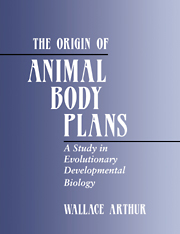 "The time is ripe for a major drive to increase our understanding of the creative side of evolution, and to correct the lopsidedness in existing evolutionary theory".
"The time is ripe for a major drive to increase our understanding of the creative side of evolution, and to correct the lopsidedness in existing evolutionary theory".
(Wallace Arthur 'The Origin of Animal Body Plans.')
According to Wallace Arthur neo-Darwinism is incomplete. Neo-Darwinism has predominantly studied how natural selection acts upon variants (population genetics), but treated the production of mutants as a black box. Furthermore neo-Darwinism almost exclusively focuses on the destructive side of natural selection: the elimination of unfavourable mutants. The creative side of evolution, the production of relevant genetic and morphological variations, is completely neglected. Palaeontologists are preoccupied by destructive processes too: extinction. The only approach to evolution that has attempted to focus on creative forces has been that of Evolutionary Developmental Biology. 'THE ORIGIN OF ANIMAL BODY PLANS' of Wallace Arthur is the manifesto of this new discipline.
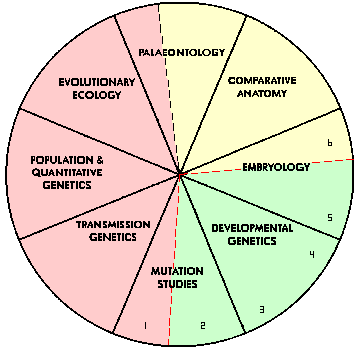
The 8 disciplines of Evolutionary Biology.
(adapted version of fig 12-1 of Wallace Arthur, 2000) |
The 3 main divisions:
| neo-Darwinism |
| classical evidence of evolutionary pattern |
| the 'missing' developmental component |
and some subdivisions:
- Mutation: Classical approach
- Mutation: Developmental approach
- Developmental Genetics: individual genes
- Developmental Genetics: networks
- Embryology: causal approach
- Embryology: comparative approach
Transmission Genetics= Mendelian genetics.
Please note that genetics occupies 50% of the circle!
|
|
| |
What has developmental biology to do with evolution? |
| |
All multicellar organisms start with 1 cell. That cell grows into an adult. Because each multicellular organism has to be build from 1 cell an opportunity arises for modification of the body plan. Developmental biology is the discipline that traditionally focusses on how multicellular organisms are build from an fertilised egg. A discipline that traditionally described spectacular transformations: from tadpole to frog, from caterpillar to butterfly, and in general from embryo to adult. If these amazing transformations are possible, why not from dino to bird or fish to human? In other words: developmental biology is relevant for evolution. But Developmental biology is also a discipline that traditionally compared the development of different organisms (comparative embryology) long before it was integrated with the disciplines of genetics or evolution. That again makes developmental biology relevant for Evolution theory (14).
We now know that the making of multicellular organisms is controlled by genes. And that mutations in those genes cause differences in morphology and body plan. And that the above mentioned spectacular transformations from tadpole to frog are controlled by genes too. But this insight is not yet included in evolution theory. Evolution theory after Darwin was based upon Mendelian genetics (after 1900), Population Genetics (after 1930), and Molecular Genetics (after 1953). To apply the knowledge that development is controlled by genes to evolutionary puzzles, the discipline Developmental Genetics needed to be part of the Evolutionary Synthesis. Exactly this is the goal of Wallace Arthur(2000). I suspect this synthesis will be elaborated the next 25 years.
|
 "The Origin of Animal Body Plans. A study in Evolutionary Developmental Biology."
"The Origin of Animal Body Plans. A study in Evolutionary Developmental Biology."
by Wallace Arthur
Cambridge University Press 1997,2000 (paperback). ISBN 0521779286. 339 pp |
Preface x
Preface to the Paperback Edition xiii
1 INTRODUCTION 1
1.1 A Developmental Approach to an Evolutionary Problem 1
1.2 The Early History of the Animal Kingdom 3
1.3 Alternative Strategies 8
1.4 Creation versus Destruction 9
1.5 Systematics and the Concept of Natural Classification 11
1.6 Micromutation versus Macromutation 16
1.7 Developing Organisms as Inverted Cones 18
2 WHAT IS A BODY PLAN? 24
2.1 Body Plans and Taxonomic Levels 24
2.2 Body Plans, Cladograms and Homology 29
2.3 Body Plans and Embryology 38
2.4 Body Plans, Genes and Mutations 42
2.5 Body Plans, Adaptation and Environments 46
3 PATTERNS OF BODY PLAN ORIGINS 51
3.1 Strategy 51
3.2 Patterns of Metazoan Interrelationships 52
3.3 Early Fossils: from Cladograms to Trees 63
3.4 Bringing Back Morphology 71
3.5 Palaeoecology and Possible Adaptive Scenarios 77
4 EVOLUTIONARY DEVELOPMENTAL BIOLOGY 81
4.1 From Pattern to Mechanism 81
4.2 The Aims of Evolutionary Developmental Biology 83
4.3 A Brief History 85
4.4 Is There a Theory of Development? 93
5 DEVELOPMENTAL MECHANISMS: CELLS AND SIGNALS 101
5.1 Strategy 101
5.2 Cellular Processes and Architecture 102
5.3 Short-range Signals: Cell-Cell Contacts 107
5.4 Mid-range Signals and the Nature of 'Morphogens' 111
5.5 Long-range Signals and Panorganismic Coordination 116
5.6 Patterns of Interconnection: Developmental Programmes 120
6 DEVELOPMENTAL MECHANISMS: GENES 126
6.1 Introduction 126
6.2 Overview of the Genetics of Drosophila Body Axes 127
6.3 The Antennapedia and Bithorax Complexes 136
6.4 The hedgehog Gene and Limb Development 143
6.5 Developmental Programmes and an Evolutionary Message 146
|
7 COMPARATIVE DEVELOPMENTAL GENETICS 149
7.1 From Development to Evolution 149
7.2 Phylogeny of Hox Genes 151
7.3 Dorsoventral Polarity in Arthropods and Chordates 169
7.4 Limb Formation, hedgehog, and the Nature of Homology 171
7.5 Phylogeny of Cadherin Genes 177
7.6 Emergent Evolutionary Messages 179
8 GENE DUPLICATION AND MUTATION 182
8.1 Introduction 182
8.2 The Creation of New Genes 184
8.3 Mutation: the Classical Approach 188
8.4 Mutation: a Developmental Approach 194
8.5 Mutation and the Evolution of Development 203
9 THE SPREAD OF VARIANT ONTOGENIES IN POPULATIONS 209
9.1 Introduction 209
9.2 Population Genetic Models of Directional Selection
9.3 Internal Selection 218
9.4 The Origin of Body Plans: a Population Perspective226
9.5 Types of Genetic Change 237
9.6 Drift, Drive and Directed Mutation 238
10 CREATION VERSUS DESTRUCTION 240
10.1 A Fourth'Eternal Metaphor'? 240
10.2 Mutationists versus Selectionists: a Protracted Debate 243
10.3 The Structure of Morphospace 247
10.4 Creation and Destruction 253
11 ONTOGENY AND PHYLOGENY REVISITED 256
11.1 Mapping the Two Hierarchies 256
11.2 From Two Hierarchies to Six 259
11.3 An Important General Pattern 264
11.4 Larval Forms and Complex Life Histories 271
11.5 Phenotypic Complexity and Evolutionary 'Explosions' 277
12 PROSPECT: EXPANDING THE SYNTHESIS 285
12.1 Neither Boredom nor Heresy 285
12.2 Completing the Evolutionary Circle 286
12.3 The Main Themes of Evolutionary Developmental Biology 291
12.4 Paths into the Future 293
References 297
Index 334
|
|
|
|
| |
Internal and external selection
|
| |
In the vast majority of mainstream evolutionary writings there is an all-pervasive emphasis on external selective agents: competition for food, predation, parasitism, disease, competition for mates, climate and geographical barriers. Darwinism centres around adaptation to external selective agents.
Internal selection is neglected. What is internal selection? A big animal with a small hart or a small animal with a big hart is internally not well adapted. Fitter organisms are 'machines' whose parts integrate better with each other. This is independent of the environment. Because internal organisation needs to be in place before an organism can do anything in any environment. In other words: the genes, cells and the organism are the internal environment of every new mutation. All genes in an organism need to cooperate to built the adult organism first before adaptation to external conditions can start having effects. The path from fertilised egg to adult has to be walked through in whatever environment. This path is studied by developmental biology (12). Obviously internal selection cannot be neglected by evolutionary theory. The sequence of genes and proteins must be explained by internal selection too. The idea of internal selection promises to explain why there are constancies in the morphology and physiology of organisms despite external adaptations (13).
|
| |
Creation and Destruction |
| |
Wallace Arthur devoted a whole chapter to the topic 'Creation versus Destruction'. Natural Selection is a destructive force. It does not create new forms. Selection is 'merely' modifying gene frequencies: eliminating disadvantageous mutations (a majority) and promoting advantageous mutations (a tiny minority of the mutations). Remarkably the critics of evolution knew this limitation of natural selection all the time. Creationists interpret this failure as a proof that evolution is unable to create new species and were quick to 'propose' an answer: a creator created all species and thereafter only some minor fine-tuning happened, which could safely be attributed to natural selection. Indeed mainstream Darwinism does not tell us much about evolutionary innovation. At most the creation of new genes is mentioned, not creation of new morphologies. Evolutionist, neo-Darwinist and textbook writer Mark Ridley made it increasingly clear to me in his Mendel's Demon (1) that the creative side of mutation was not only missing in the neo-Darwinian Synthesis, but was not even seen as an urgent problem. Ridley even claimed that mutations are a net disadvantage, leaving hardly any room for positive mutations. Besides: the neo-Darwinian Synthesis was completed more than 50 years ago, so nothing substantial could be added. However according to Wallace Arthur "The time is ripe for a major drive to increase our understanding of the creative side of evolution, and to correct the lopsidedness in existing theory" (p243). Evolutionary Developmental Biology is by its very nature able to show the creative side of evolution.
|
| |
Micro and Macro mutation |
| |
The standard neo-Darwinist view is that micro- as well as macro-evolution can be explained by micro-mutations. There is no need for macro-mutations. Macro-mutations can only produce 'monsters'. There are no beneficial macro-mutations. Mainstream evolutionary theory always considered macro-mutations as heretic. For example the famous Goldschmidt 'hopeful monsters' were rejected and ridiculed. As a good Darwinist Richard Dawkins always defended the sufficiency of micro-mutations and many small steps (gradualism). So neo-Darwinism is characterised as gradualist/externalist (see above paragraph internal - external selection). According to Arthur the dichotomy micro-macro is wrong, because there is a continuous scale from micro to macro with respect to effects on the phenotype. Secondly usually only the effect on the adult organism is considered. But a big difference in the adult usually starts in development as a small change: a few molecules, a few cells.
|
| |
Other sources |
| |
Wallace Arthur is an open-minded neo-Darwinist, an innovator, a Synthesis builder. His wide interest includes books and authors that have been at the periphery of mainstream evolution biology, struggling for recognition. He is clearly interested in the limitations and open questions of evolutionary biology. He systematically discusses how development could answer long-standing evolutionary questions. Furthermore I am convinced that Arthur's ideas are the most satisfactory and elaborated addition to Evolution Theory after the so-called 'Evolutionary Synthesis'. We could justifiably call his work the agenda for 'The Second Evolutionary Synthesis'. Because so many of his themes are central to evolutionary thinking we find many links with other authors. It is clear from the literature that Arthur is not the first author proposing the 'evo-devo' approach. John Maynard Smith (2) proposed the same idea in a small booklet:
"Evolutionary theory is largely concerned with changes in the frequencies of genes in populations, brought about by mutation, natural selection and other processes. What we observe in evolution are changes in the forms of animals and plants. To link theory and observation, we need to know how changes in genes cause changes in morphology, and that requires an understanding of development." This shows that even an ultra-orthodox evolutionist perceives the need for integration of Developmental biology into evolution. Furthermore the need was felt some 50 years ago according to JMS! Brian Goodwin (3) already criticised evolutionists ("something is missing in biology") and pointed out that we need a "science of form", but he denied a genetic control of the developmental process and ended up in a dead mathematical alley. Stuart Kauffman (4) too thinks that something is missing in biology, but sought the solution in auto-catalysis and complexity theory, which did not (yet) result in a breakthrough in our understanding of evolution either. Gabriel Dover (5) is certainly interested in the connection between evolution, genetics and development, but he didn't discuss it in a systematic way. In other works such as Enrico Coen (6) and Walter Gehring (7) developmental genetics is primary, and evolution is present but secondary. A good example of what developmental genetics can contribute to evolution theory is Sean Carroll (8), especially the chapter 'The Evolution of Morphological Novelties'. Finally in Wallace Arthur's book evolutionary theory is primary and development is seen as an extremely important building block of the theory of evolution. He clearly aimed at establishing a new discipline: 'Evolutionary Developmental Biology'. For the relation with other biological disciplines see the figure 'The 8 disciplines of Evolutionary Biology'. What the 'First Evolutionary Synthesis' was, is described by Betty Smocovitis (9). A special case is embryologist and Darwin critic Soren Lovtrup (10) who anticipated a number of ideas expressed in Arthur's book. For example the importance of development for evolution: "If we confine ourselves to the evolution of form, then we may observe that evolution ... has consisted in the origination of new morphogenetic mechanisms, capable of creating new kinds of body plan".
|
| |
Unfinished Forever? |
| |
Is this the Final Synthesis? Is neo-Darwinism complete after the inclusion of Developmental Biology? Or will the Darwinian Symphony forever be unfinished? I prefer to reserve a part of the evolutionary circle for unknown future disciplines. And there are a number of disciplines missing right now in Arthur's synthesis (they are outside the scope of his book). For example botany. Plants have body plans which include a vertical axis, and axes for leaves and flowers. Recently a comparative study of the development of animals and plants has been initiated (11). And disciplines such as genomics, sociobiology (now more than 25 years old!), behavioural genetics, and evolutionary psychology are missing too.
 Wallace Arthur (2004) Biased Embryos and Evolution.
Wallace Arthur (2004) Biased Embryos and Evolution.
Cambridge University Press, paperback, 233 pages. Info.
"The core of the book deals with a single, controversial question of the utmost importance: do biases in the ways in which embryos and other developmental stages can be modified provide a sort of internal 'direction-finder' to the process of evolution that interacts with its external equivalent, namely natural selection? It is this core question - and my proposed answer of 'yes' to it- that gives the book its name."
"How can a theory of evolution that purports to explain how creatures with trillions of cells arose from unicellular beginnings be taken seriously if all it tells us is that differential rates of destruction can alter the genetic composition of populations?" (p. 36).
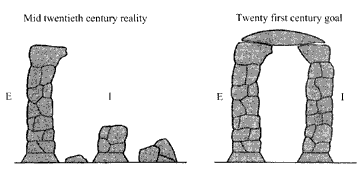 |
Evolution theory as an archway, one of whose pillars requires more attention than the other in the 21st century.
E = external, I = internal (page 72). |
This short, accessible and insightful book is written for non-specialists interested in new directions in evolution research and theory. Recommended. There is a review in Nature 430, 294 (15 July 2004) of the book by Armand Leroi: Gentle biases. He emphasises that the book is for the general reader, but unfairly criticises it as if it were for written for the specialist.
|
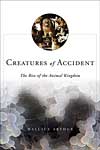 Wallace Arthur (2006) Creatures of Accident: The Rise of the Animal Kingdom Hardcover
Hill and Wang (September 5, 2006) 22 Sep 06.
Wallace Arthur (2006) Creatures of Accident: The Rise of the Animal Kingdom Hardcover
Hill and Wang (September 5, 2006) 22 Sep 06.
The book is for the general public, but unfortunately is not illustrated. As the title implies, this book does not include
the evolution of plants. Conversational style. It does include a chapter about evolution and religion, Glossary, Index, No Notes.
Reviewed by Matthew A. Wills in Nature Vol 443 12 October 2006 page 633. ("Arthur's science, although beautifully simplified and readable, is never simplistic. ... Creatures of Accident richly deserves to be read widely. With biology teaching becoming increasingly reductionist, it offers the (gloriously coined) 'megaevolutionary' perspective. Lay readers will find plenty of surprises, and those with a more scientific background will find Arthur's straightforward and nonposturing style hugely enjoyable."). Creatures of Accident is reviewed by Paul Gross in the Skeptic.
|
|
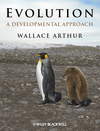 Wallace Arthur (2010) 'Evolution: A Developmental Approach', Wiley-Blackwell, Paperback 416 pages
Wallace Arthur (2010) 'Evolution: A Developmental Approach', Wiley-Blackwell, Paperback 416 pages
The core theme in this book is how evolution works by changing the course of embryonic and post-embryonic development ('evo-devo').
Info including a full table of contents. This book has a companion website: www.wiley.com/go/arthur/evolution .
|
|
| |
Notes
- Mark Ridley(2000) Mendel's Demon, see paragraph 'Is error elimination the core of neo-Darwinism?' of the review.
- John Maynard Smith(1998) Shaping Life. Genes, Embryos and Evolution, p3. (review)
- Brian Goodwin(1995) How the Leopard Changed Its Spots. (review)
- Stuart Kauffman(1995) At Home in the Universe. (review)
- Gabriel Dover(2000) Dear Mr Darwin. Letters on the Evolution of Life and Human Nature. (review)
- Enrico Coen(1999) The Art of Genes. How organisms make themselves.
- Walter Gehring(1998) Master Control Genes in Development and Evolution. The Homeobox Story.
- Sean Carroll et al(2001) From DNA to Diversity. Molecular Genetics and the Evolution of Animal Design.
- Betty Smocovitis(1996) Unifying Biology. The Evolutionary Synthesis and Evolutionary Biology. (review)
- Søren Løvtrup(1987) Darwinism: The Refutation of a Myth, p376. This book is not in the reference list of W. Arthur. (review)
- Elliot Meyerowitz(2002) Plants compared to animals: the broadest comparative study of development, Science Vol 295, 22 Feb 2002, pp1482-1485.
- "Traditional models for developmental biology — such as the fly — were chosen because their phenotypic traits directly reflect their genotype, with minimal environmental input. These models are poorly suited to questions asked by scientists in emerging fields such as ecological developmental biology — 'eco-devo' — which focuses on external influences on developing phenotypes."
"Take modern developmental biology. The field has centred on small, rapidly developing organisms with short generation times — most typically, Drosophila and C. elegans. Much of our current understanding of developmental principles is based on experiments in these species. However, evolutionary selection for rapid development has broad implications. It seems to favour stronger genetic control during development and less plasticity (or flexibility). Compared with related species, development in the models is less responsive to external signals, whether adaptive or disruptive"
from: Jessica Bolker (2012) Model organisms: There's more to life than rats and flies, Nature 1 Nov 2012.
- Richard N. McLaughlin Jr (2012) The spatial architecture of protein function and adaptation, Nature, 1 Nov 2012
" most residues in proteins evolve nearly independently, without much influence from even their immediate structural environment, whereas about 20% of amino acids are organized into physically contiguous networks of coevolving amino acids, termed protein sectors".
- "The evolutionary biologist Leigh Van Valen famously defined evolution as the control of development by ecology. By this, he meant that evolution is governed by the fitness of the phenotype of an organism (its physical form); that fitness depends on the ecological context in which the phenotype exists; and that an individual's phenotype is not a static structure built directly from genes, but a dynamic structure that unfolds sequentially from fertilization to adulthood. The developmental sequence determines and constrains which phenotypes can emerge, such that evolutionary change depends on modifications to development."! P. David Polly (2013) Evolution: Stuck between the teeth, Science 16 May 2013. This is precisely the same idea as Wallace Arthur explains in his book The Origin of Animal Body Plans.
Links
- Home page of Prof. Wallace Arthur at Sunderland University, UK.
- Wallace Arthur(2002): The emerging conceptual framework of evolutionary developmental biology, Nature 415, 757-764, Review article. 14 Feb 2002.
- review of The Evolution of Developmental Pathways, Adam S. Wilkins. Science Volume 296, Number 5576, Issue of 21 Jun 2002, pp. 2147-2148.
- The Bookshelf talks with Wallace Arthur in American Scinetist online.
"What are the three best books you've ever read? The answer to this comes from the combination of my maverick tendency and my interest in evolution: Darwin's On the Origin of Species
(1859) -he may be orthodox now, but he wasn't then; On Growth and Form, by D'Arcy Thompson (1917), for its demonstration of how evolution often produces coordinated developmental changes in animal bodies; and Internal Factors in Evolution, by Lancelot Law Whyte (G. Braziller, 1965), which emphasizes the importance of internal coadaptation of the different parts of a creature as opposed to the creature's external adaptation to its environment, and does so with commendable brevity."
- EvoDevo, Journal. "EvoDevo publishes articles on a broad range of topics associated with the translation of genotype to phenotype in a phylogenetic context. Understanding the history of life, the evolution of novelty and the generation of form, whether through embryogenesis, budding, or regeneration are amongst the greatest challenges in biology. We support the understanding of these processes through the many complementary approaches that characterize the field of evo-devo."
Further Reading
- See for an overview of evo-devo literature the Introduction page section evo-devo.
- Sean Carroll, Jennifer Grenier, Scott Weatherbee (2001): From DNA to Diversity. Molecular Genetics and the Evolution of Animal Design.
The best illustrated, educational, accessible and modern evo-devo introduction for the non-specialist. Absolutely recommended. A masterpiece of popular science writing and an attractive layout. And very much Evolutionary Developmental Biology. The authors are at the Howard Hughes Medical Institute. Their website has been awarded by the Scientific American: The Genes We Share with Yeast, Flies, Worms and Mice.
 Sean Carroll, Jennifer Grenier, Scott Weatherbee (2001): From DNA to Diversity. Molecular Genetics and the Evolution of Animal Design.
Sean Carroll, Jennifer Grenier, Scott Weatherbee (2001): From DNA to Diversity. Molecular Genetics and the Evolution of Animal Design.
Blackwell Science. Paperback.
214 pages.
Preface.
1. A Brief History of Animals.
2. The Genetic Toolkit for Development.
3. Building Animals.
4. Evolution of the Toolkit.
5. Diversification of Body Plans and Body Parts.
6. The Evolution of Morphological Novelties.
7. From DNA to Diversity: The Primacy of Regulatory Evolution.
Glossary
Index
(The second edition paperback appeared in 2004 ).
|
|
- Kenneth M Weiss, Anne V Buchanan (2004) Genetics and the Logic of Evolution. The authors try to create a more complete theory of evolution by a rethinking of how organisms are created from genes and how genomes create diversity of life on earth (similar to the evo-devo approach). See for a summary by Kenneth M.Weiss: THE PHENOGENETIC LOGIC OF LIFE, Nature Review Genetics 36 | JANUARY 2005 | VOLUME 6. nature.com/reviews/genetics 21 Jan 05
- Sean B. Carroll (2005) Endless Forms Most Beautiful: The New Science of Evo Devo and the Making of the Animal Kingdom. Publisher: W. W. Norton & Company hardback 350 pages (April 11, 2005). Review in the Scientific American (April 2005) by Brian Hall. 3 Apr 05
- Review of Origination of Organismal Form: Beyond the Gene in Developmental and Evolutionary Biology (2003). 28 Jan 06
- Eric H. Davidson and Douglas H. (2006) "Gene Regulatory Networks and the Evolution of Animal Body Plans", Science 10 February 2006 Vol 311 796-800.
- Wallace Arthur (1987) Theories of Life. Darwin, Mendel and beyond. Penguin Books.
- Wallace Arthur (2006) "D'Arcy Thompson and the theory of transformations", Nature Review Genetics p401 | 10.1038/nrg1835. Summary: Understanding how developmental processes are altered evolutionarily to produce changes in organismal form is one of the great challenges of evo-devo research. D'Arcy Wentworth Thompson deserves much credit for the inspiration his work has provided for modern evo-devo. 18 Apr 06
- Wallace Arthur (2007) The search for novelty,
Nature 447, 261-262 (17 May 2007) is a review of Manfred Laubichler & Jane Maienschein (2007) From Embryology to Evo-Devo: A History of Developmental Evolution.
- Making Visible Embryos.
- Zhe-Xi Luo (2014) Evolution: Tooth structure re-engineered, Nature, 7 Aug 2014.
- A fundamental connection between developmental changes and evolution has long been established. This link is gaining renewed emphasis as molecular studies shed new light on evolution by revealing many genetic modifications that alter developmental processes, in turn changing an organism's shape and structure. Harjunmaa et al report in 'Replaying evolutionary transitions from the dental fossil record' that, by simply tinkering with the genes and signalling pathways that control the shape of developing teeth, they have remade several different tooth structures in vitro. These structures draw a striking parallel with how teeth evolved from those of distant mammalian ancestors to the teeth of modern-day rodents.
|


 "The time is ripe for a major drive to increase our understanding of the creative side of evolution, and to correct the lopsidedness in existing evolutionary theory".
"The time is ripe for a major drive to increase our understanding of the creative side of evolution, and to correct the lopsidedness in existing evolutionary theory".